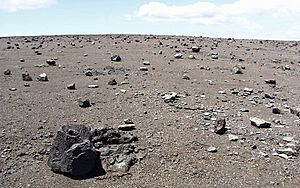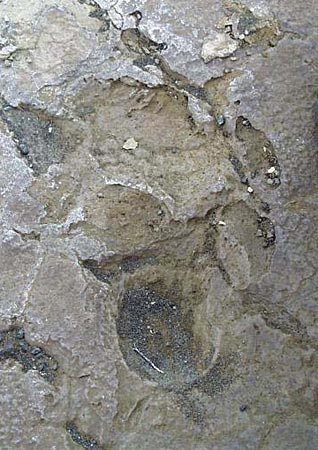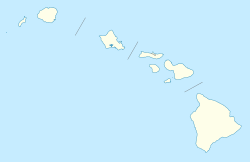1790 Footprints facts for kids
The 1790 Footprints are a famous set of footprints found near the Kīlauea volcano. You can see them today in Hawaii Volcanoes National Park on the island of Hawaiʻi. These footprints were made during a very powerful volcanic eruption in 1790. Some people believe they are linked to battles that happened in the area at the same time.
Quick facts for kids East Hawaiʻi Battles of 1790 |
|||||||
|---|---|---|---|---|---|---|---|
| Part of Unification of Hawaii | |||||||
 Ash layer from 1790 eruption. |
|||||||
|
|||||||
| Belligerents | |||||||
| Kamehameha I's army | Keōua Kuahuʻula | ||||||
| Commanders and leaders | |||||||
| Kamehameha I Keawemauhili |
Keōua Kuahuʻula | ||||||
|
1790 Footprints
|
|
 |
|
| Location | 9.1 mi. SW of park headquarters on Hwy. 11, then foot trail to SE for 1 mi., Hawaii Volcanoes National Park, Hawaii |
|---|---|
| Area | 4,284 acres (17.34 km2) |
| Built | 1790 |
| NRHP reference No. | 74000351 |
| Added to NRHP | August 7, 1974 |
Contents
The Story Behind the Footprints
Battles and Volcanoes
Back in 1782, a big battle called the Battle of Mokuʻōhai took place. After this battle, a powerful leader named Kamehameha I gained control of the western and northern parts of Hawaiʻi Island. However, two other important leaders, Keōua Kuahuʻula and his uncle Keawemauhili, managed to escape.
For a few years, Kamehameha was busy with other islands and meeting European visitors. During this time, Keōua ruled the area called Kaʻū, and Keawemauhili ruled Hilo.
By 1790, Keawemauhili and Kamehameha had made peace. Keawemauhili even helped Kamehameha invade Maui that year. This cooperation broke an earlier agreement between Keawemauhili and Keōua.
Keōua's Attack
Keōua was very angry about this. While Kamehameha was away fighting in Maui, Keōua attacked some of Kamehameha's lands.
Then, Keōua attacked and killed his own uncle, Keawemauhili, in Hilo. When Kamehameha returned from Maui, Keōua set a trap for his army in a thick forest near Paʻauhau. The battle there was fierce but didn't have a clear winner.
Kamehameha fought back in a battle known as the Battle of Koapapaʻa. He even had a cannon from a captured ship called the Fair American. Keōua managed to capture the cannon, but he didn't have gunpowder or know how to use it. After many losses on both sides, both leaders decided to retreat to their safe areas.
The Eruption and the Footprints
People used to think the footprints were left by Keōua's soldiers as they retreated. As they passed the Kīlauea volcano, they stopped to make offerings to the goddess Pele. They then set up camp.
When the volcano began to erupt, they worried they had upset Pele. Keōua split his group into three and stayed behind to make more offerings.
Two groups of warriors were caught in a sudden, hot cloud of gas and ash called a pyroclastic flow. Only one group of three survived. An early geologist named Thomas Jaggar believed the footprints belonged to the warriors who died in this event.
Later, in 1791, Keōua was killed at Kawaihae.
The "Falling Sand"
Ancient Hawaiians kept detailed stories by speaking them, but they didn't count years like we do today. One important event in their stories was called Ke one helelei, which means "the falling sand" in the Hawaiian Language.
This event matched an eruption that a British sailor named John Young saw in 1790. It was probably given this special name because it was a very unusual type of eruption for Hawaiian volcanoes.
New Discoveries About the Footprints
Who Made the Footprints?
More recent studies suggest that some, or even all, of the footprints might have been made by everyday people, not just warriors.
Scientists did detailed surveys in 1998 and 2000. They even used radiocarbon dating on tiny pieces of charcoal found nearby. They discovered many old living sites and trails. This showed that people used the area for hundreds of years, even during volcanic activity between 1500 and 1790.
Modern Science Helps
In 2008, scientists used modern forensic techniques, like those used to solve crimes. They found that many of the footprints were made by women and children, not just male warriors.
These people were probably already in the area, perhaps chipping off sharp pieces of volcanic glass to use as tools. They likely left the footprints while escaping during a short break in the eruption.
Keōua's groups, however, were at the top of the volcano. Some were killed instantly by a blast of poisonous gas, not by the falling ash itself.
Even though they are sometimes called "fossilized," these imprints are not old enough to be true fossils. The fine ash probably mixed with rain, turning into thick mud. This mud then quickly hardened in the hot sun and was preserved in the dry desert.
Protecting the Footprints
How They Were Found
The footprints were found by accident by a geologist named Ruy H. Finch. He was exploring the hardened ash of the Kaʻū Desert while studying a 1919 eruption.
At that time, the land where the footprints were found was not part of Hawaii Volcanoes National Park. In 1938, there was a plan to use the area as a bombing practice range. Many groups protested to protect the site.
On June 20, 1938, the U.S. government bought the land to add it to the park. The bombing range was limited to a smaller area. The Army never used the land, but the Navy caused some injuries to fishermen in 1945. In June 1950, the bombing range was given back to the park after all unexploded bombs were removed.
Visiting the Site
In 1941, a group called the Civilian Conservation Corps built a trail and a shelter for visitors. The footprint site is an important archaeological site for Hawaiʻi. It was added to the National Register of Historic Places on August 7, 1974.
To visit the area, you can drive about 9.1 miles (14.6 km) southwest from the park headquarters on Highway 11. From this starting point, the Footprints Trail leads about one mile (1.6 km) southeast to the area.
For a longer hike, you can start at the Kaʻū Desert trailhead on Crater Rim Drive. This hike is about five miles (8 km) through the area. Remember to check with the park rangers before you go. These trails might be closed if the volcano is very active.


